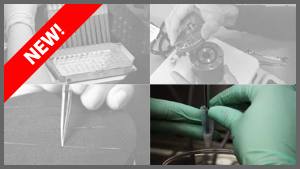BenchFly Welcomes the Proteomics Community!
by
 Today, we are proud to announce the addition of a new Proteomics category at BenchFly! As a field, proteomics – the large-scale study of protein structure and function – has rapidly evolved since it’s birth in the late 1990s. Over the years, advances in laboratory techniques and instrumentation have played a dominant role in fueling this growth and we are excited to be a part of it.
Today, we are proud to announce the addition of a new Proteomics category at BenchFly! As a field, proteomics – the large-scale study of protein structure and function – has rapidly evolved since it’s birth in the late 1990s. Over the years, advances in laboratory techniques and instrumentation have played a dominant role in fueling this growth and we are excited to be a part of it.
Studying the fate of a single protein within a cell is nearly as complicated as trying to understand a political candidate during an election year. Both their structure (physical appearance) and function (beliefs) can be reversibly altered depending on external stimuli, the local environment and time. While it’s unlikely that p53 will flip-flop on taxes, it is certain that characterizing the protein’s phosphorylation state and binding partners will further our understanding of it’s role in biological processes.
By defining the physical states of tens, hundreds or even thousands of proteins in a single sample, researchers can compare the resulting protein signatures of healthy and diseased tissues. Observed differences in the biochemical fingerprints provide information that may be used to define, diagnose and treat disease. The remarkable ability to detect individual protein levels and modifications in a handful of cells or a small tissue biopsy is a result of the exquisite sensitivity of mass spectrometry. However, such precision means even subtle variations in sample preparation, instrument set-up or run procedure may significantly affect the data collected making it difficult to compare results lab-to-lab.
“The proteomics community has devoted considerable effort to understand sources of variability in proteome analysis platforms.” said Dr. Daniel Liebler, Director of the Jim Ayers Institute for Precancer Detection and Diagnosis at Vanderbilt University. “Recent work has identified two of the most important sources of variation as sample preparation and peptide separations. Using BenchFly, we can explicitly demonstrate our protocols in detail. A video demonstration captures key information that simply doesn’t translate very well through the methods section in a manuscript.” We feel BenchFly is the perfect place to bring the community together to share techniques, recommend reagents and define standard protocols.
We at BenchFly are proud to be considered part of the proteomics community and we welcome the opportunity to help researchers share the tips, tricks and techniques they’ve mastered in their own labs! So show the new Proteomics category some love by heading over and checking out a few of the techniques!
.
Would you like to see your field represented with it’s own category? Drop us a line and let us know at [email protected].
.


Corbin Whitwell
wrote on March 26, 2010 at 8:15 pm
I LOVE it!!! We love you Alan!